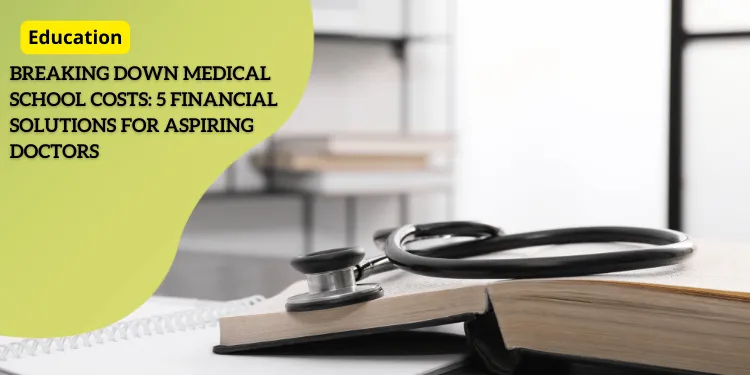Breaking Down Medical School Costs: 5 Financial Solutions for Aspiring Doctors

Anúncios
The financial burden of medical education continues to rise, impacting a significant portion of aspiring doctors.
According to the Education Data Initiative, 73% of medical school graduates carry educational debt.
Anúncios
On average, this debt amounts to a staggering $234,597 for a four-year medical school education.
Notably, this figure does not even account for any undergraduate debt that students may have accumulated prior.
Anúncios
Increasing Tuition Costs
One of the primary contributors to this overwhelming debt is the annual increase in tuition fees.
Medical schools nationwide experience tuition hikes that exceed $1,000 each year.
Dr. Jen Brull, president of the American Academy of Family Physicians, highlights that despite adjusting for inflation, the cost of attending medical school today is substantially higher than it was two decades ago.
Students entering med school are often unprepared for these escalating costs, which can create a cumulative financial strain over time.
As tuition rises year-on-year, students can find themselves facing greater debt loads upon graduation.
The Implications of High Debt
High levels of debt can influence new physicians’ career choices, potentially steering them away from lower-paying specialties, such as primary care or family medicine, which are crucial to healthcare accessibility.
Instead, many graduates may opt for higher-paying specialties to manage their debt more effectively.
Strategies to Cope
Fortunately, there are several strategies aspiring doctors can leverage to address the steep costs of their medical education.
These solutions, spanning from scholarships and grants to service-based debt relief programs, offer avenues to ease the financial burden.
Next, we’ll explore various scholarship opportunities, such as those provided by universities and private organizations, which can significantly reduce or even eliminate tuition costs.
With thoughtful planning and resourcefulness, students can find financial relief and focus more intently on their medical training instead of its associated expenses.
Scholarships and Grants: Finding Free Money
University Scholarships and Grants
Scholarships and grants can significantly cut the cost of medical education.
Many universities offer these financial aids to help students manage their medical school expenses.
For instance, the IU School of Medicine provides a robust scholarship program, distributing over $10 million annually to its students.
Scholarships at IU start at the time of matriculation and continue throughout the students’ education.
The David Geffen School of Medicine at UCLA offers over 100 scholarships, including the prestigious L.A.
Care’s Elevating the Safety Net Scholarship.
This program awards up to $350,000 each year to eight community-minded medical students, covering their full tuition.
Nonprofit and Private Sector Scholarships
Nonprofits and private companies also offer various scholarships to medical students.
These scholarships often target specific student populations or areas of study, such as rural health or minority health disparities.
Students can find these opportunities through searchable databases and should consult their medical school’s financial aid office to discover all available options.
Full-Tuition Scholarships
Beyond partial scholarships, some medical schools offer full-tuition scholarships to all admitted students.
New York University’s Grossman School of Medicine and the Cleveland Clinic Lerner College of Medicine at Case Western Reserve University both provide full-tuition scholarships to their students.
The Kaiser Permanente School of Medicine in Pasadena offers free tuition in perpetuity for all medical students, starting with its inaugural class.
Johns Hopkins University also stands out by announcing full cost-of-attendance financial aid packages for students whose families earn under $175,000 starting in 2024.
Those with family incomes below $300,000 can receive scholarships that cover tuition costs.
Maximizing Scholarship Opportunities
Students should maximize their scholarship opportunities by regularly searching online databases and consulting with their advisors.
Applying for various scholarships, understanding eligibility criteria, and meeting deadlines can make a big difference.
Next, let’s dive into some tuition reduction strategies, which can also play a crucial role in managing the exorbitant costs of medical education.
Tuition Reduction Strategies
Teaching Assistant Positions
Taking on a teaching assistant (TA) role during medical school can provide substantial financial relief.
Many medical schools offer reduced tuition or stipends to students who assist professors with teaching responsibilities.
Duties for TAs can include tutoring, managing classroom resources, or helping to grade assignments.
These positions not only help cut down on tuition costs but also provide valuable teaching experience, which can be an asset in a medical career.
Participating in Medical Research
Engaging in medical research while pursuing your degree is another effective way to reduce tuition expenses.
Many research opportunities come with grants or scholarships, particularly in high-need areas such as rural health, public health, or minority health disparities.
Medical schools often have dedicated offices or faculty members to help students identify and apply for these research grants.
Participating in research not only helps financially but also enhances a student’s resume, making them more competitive in the job market.
Income-Based Tuition Assistance Programs
Several medical schools offer income-based tuition assistance programs.
These programs adjust the amount of financial aid based on the student’s or their family’s income, effectively decreasing the out-of-pocket cost for those in lower-income brackets.
For instance, starting in fall 2024, Johns Hopkins University will provide full cost-of-attendance financial aid packages for students whose families earn under $175,000, and substantial tuition scholarships for those earning less than $300,000.
Income-based programs are designed to make medical education more accessible to students from diverse economic backgrounds, ensuring that a lack of financial resources does not hinder one’s ability to pursue a career in medicine.
By leveraging these tuition reduction strategies, aspiring doctors can significantly lessen the financial burden of medical school.
This, in turn, allows future medical professionals to focus more on their education and less on financial concerns.
To further alleviate their financial stress, medical students can also consider service-based debt solutions.
These programs provide additional ways to manage and reduce educational debt through service commitments.
Service-Based Debt Solutions
Service-based debt solutions offer a practical way for aspiring doctors to manage their educational loans.
By committing to service in high-need areas, medical students can not only reduce their debt but also gain valuable professional experience.
Here are three primary avenues to explore.
National Health Service Corps Programs
The National Health Service Corps (NHSC) offers a win-win solution: scholarships in return for service in designated Health Professional Shortage Areas.
Students who commit to providing primary care in these underserved locations can receive generous scholarships that cover tuition, fees, and other educational expenses.
These programs typically require a service commitment of at least two years, providing vital healthcare services where they are most needed.
Military Scholarship Programs
For those interested in serving their country while earning their medical degree, military scholarship programs present an attractive option.
Programs like the Health Professions Scholarship Program (HPSP) offered by the U.S. Army, Navy, and Air Force cover complete tuition and fees, as well as a monthly stipend.
In exchange, graduates must serve as military physicians after completing their medical training.
This pathway not only alleviates financial stress but also provides unmatched training opportunities within the military healthcare system.
State-Specific Loan Repayment Programs
Many states have developed their own loan repayment programs to address healthcare provider shortages.
These programs typically offer loan repayment assistance in exchange for a commitment to work in high-need areas for a set period, usually ranging from two to three years.
For instance, the Hawai’i State Legislature recently allocated $30 million over two years to their loan repayment program, offering up to $50,000 per year for qualifying medical professionals.
These state-specific programs vary widely, so it’s essential to research opportunities within your state to find the best fit for your career goals and financial needs.
Pursuing a career in medicine comes with significant financial challenges, but service-based solutions provide meaningful ways to ease that burden while making a positive impact.
Next, let’s explore how post-graduation financial relief options can further support your journey in medicine.
Post-Graduation Financial Relief
Public Service Loan Forgiveness (PSLF)
The Public Service Loan Forgiveness (PSLF) program offers a beacon of hope for medical graduates overwhelmed by educational debt.
Designed for professionals working full-time at qualifying non-profits or government agencies, PSLF forgives the remaining student loan balance after 120 qualifying monthly payments.
This includes work at non-profit or public hospitals, which many physicians naturally gravitate towards.
For those willing to commit a decade to public service, PSLF can be a lifeline.
Even volunteer service programs like the Peace Corps qualify, whereby volunteers can make minimal payments that still count towards PSLF.
Contacting the Department of Education or your loan servicer is crucial to ensure your eligibility and understand the payment requirements.
Signing Bonuses
With the rising demand for physicians, there is an enticing financial perk on the horizon: signing bonuses.
According to a 2024 report from AMN Healthcare, the average physician signing bonus is $31,473.
These bonuses can provide significant relief when allocated towards student loan repayment.
While beginning your medical career, leveraging this bonus can significantly cut down your debt, allowing you to start on a healthier financial footing.
Peace Corps Service
The Peace Corps may not be the first avenue aspiring physicians consider, but it holds substantial financial and professional benefits.
Serving as a Peace Corps volunteer not only offers a chance to make a profound impact but also counts towards the PSLF program.
With many health initiatives requiring medical expertise, volunteers can make a difference while making strides towards debt forgiveness.
This unique combination of service and financial relief can transform both your career and debt outlook.
With these post-graduation financial relief options, graduates can navigate the daunting landscape of medical school debt.






